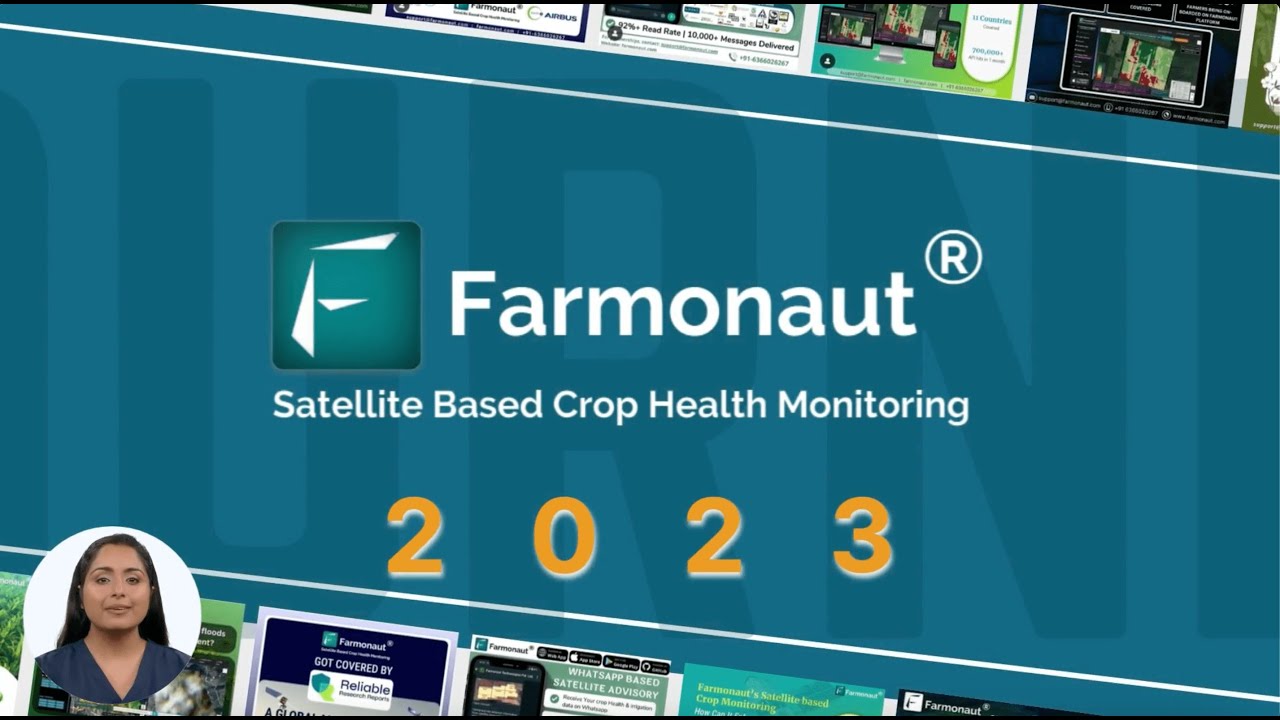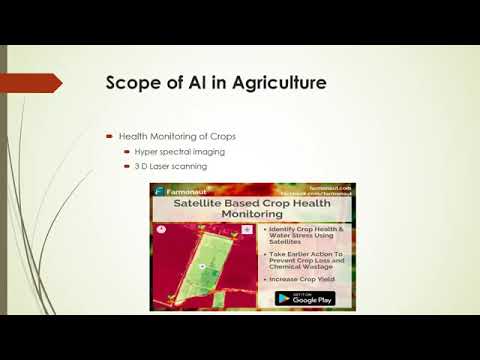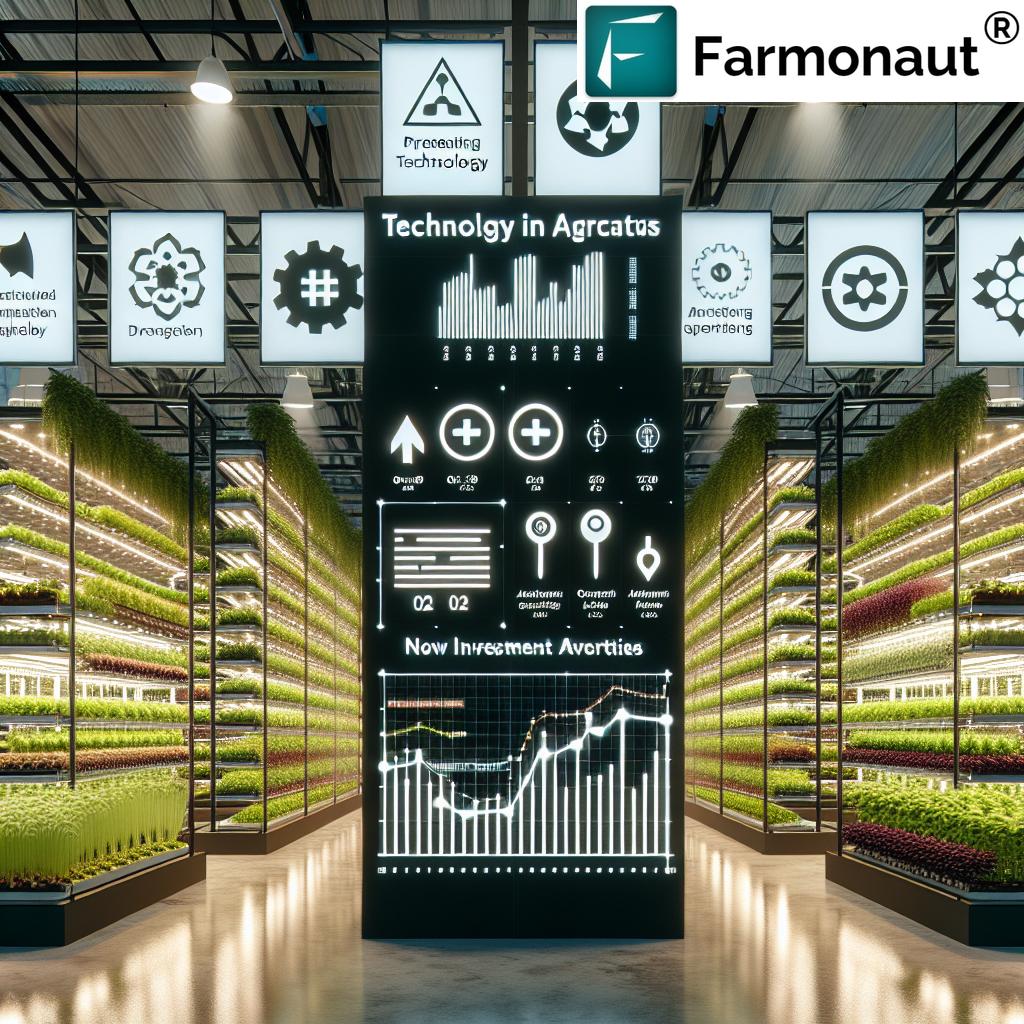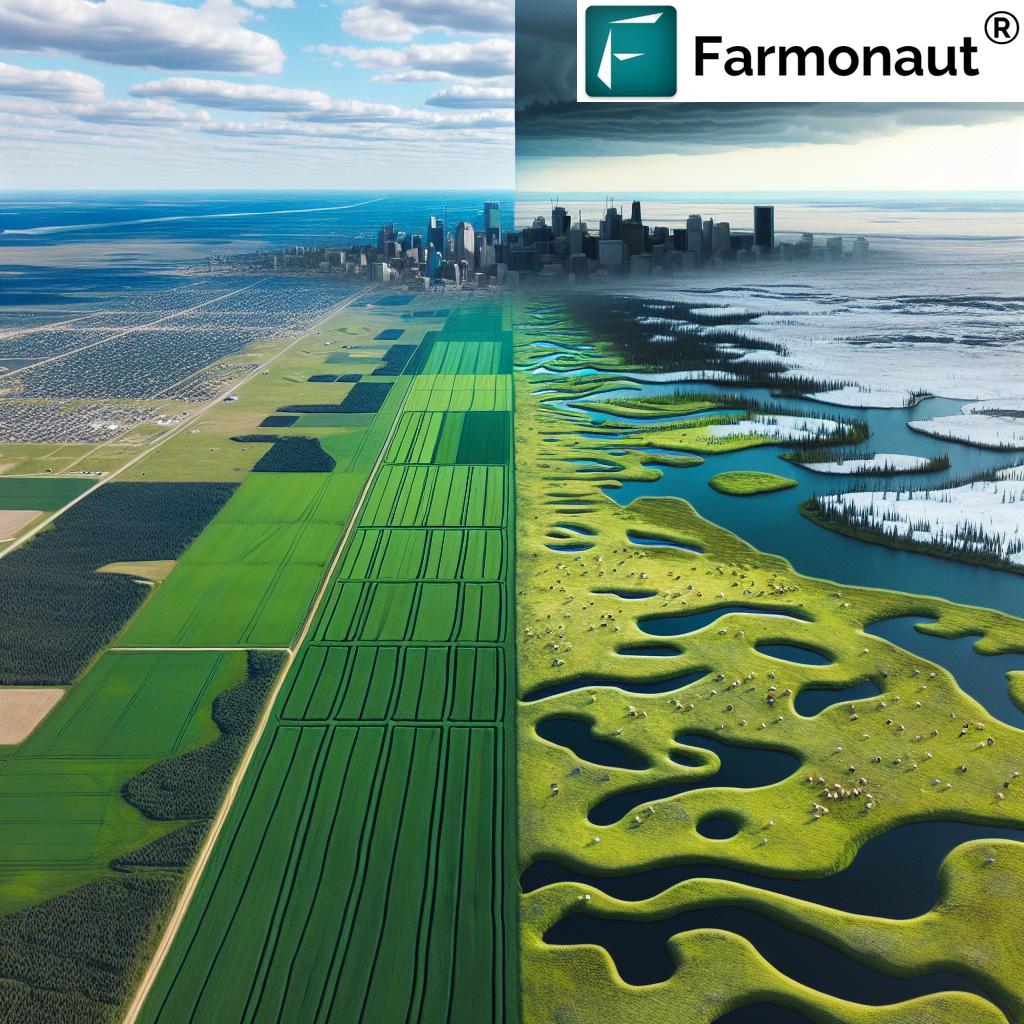Sustainable Dairy Farming in Canada: How Farmonaut Empowers Farmers to Achieve Net-Zero Emissions by 2050
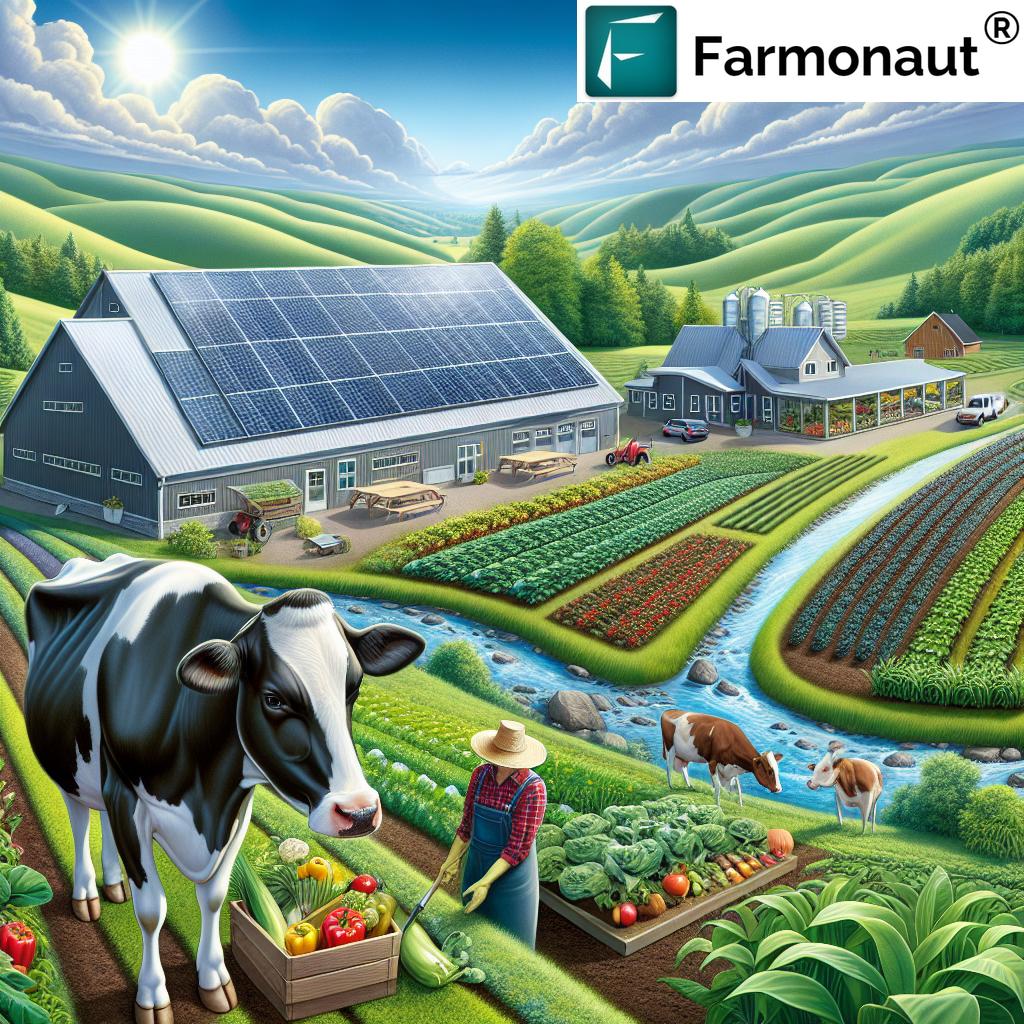
“Canadian dairy farmers aim to achieve net-zero emissions by 2050, demonstrating a strong commitment to environmental sustainability.”
In the vast landscape of Canadian agriculture, dairy farming stands as a cornerstone of our national identity and economy. As we navigate the challenges of the 21st century, the Canadian dairy industry is undergoing a remarkable transformation, embracing sustainability as a guiding principle. In this comprehensive exploration, we’ll delve into the innovative practices and cutting-edge technologies that are reshaping sustainable dairy farming across our nation, from the lush pastures of Quebec to the rolling hills of British Columbia.
At the heart of this revolution is the industry’s ambitious goal: achieving net-zero emissions by 2050. This commitment reflects not just a response to global climate concerns but a proactive stance in safeguarding the future of Canadian agriculture. As we unpack this journey, we’ll explore how farmers are balancing the demands of high-quality milk production with environmental stewardship, animal welfare, and the preservation of our rich biodiversity.
Central to this transformation is the role of innovative technologies, and at the forefront of this technological revolution is Farmonaut. This pioneering agricultural technology company is empowering Canadian dairy farmers with advanced, satellite-based farm management solutions. Through its comprehensive platform, Farmonaut is making precision agriculture not just a possibility but an accessible reality for farmers across the country.
The Current Landscape of Canadian Dairy Farming
Before we dive into the future of sustainable dairy farming, let’s take a moment to appreciate the current state of the industry in Canada. Our dairy sector is renowned for its high standards of quality, animal care, and environmental responsibility. Spanning from the Atlantic to the Pacific, Canadian dairy farms are as diverse as our landscape, each adapting to unique regional challenges while maintaining a unified commitment to excellence.
- Economic Impact: The dairy industry contributes significantly to Canada’s economy, supporting tens of thousands of jobs and generating billions in GDP annually.
- Quality Standards: Canadian milk is recognized globally for its high quality, thanks to stringent regulations and the dedication of our farmers.
- Regional Diversity: From the large operations in Ontario and Quebec to the family-run farms in the Prairies and the Maritimes, each region brings its unique flavor to Canadian dairy.
The Path to Net-Zero: Challenges and Opportunities
The journey to net-zero emissions by 2050 is ambitious, but it’s a challenge that Canadian dairy farmers are embracing with characteristic determination and innovation. This goal encompasses every aspect of dairy farming, from feed production to waste management, and requires a holistic approach to sustainability.
Key Areas of Focus:
- Reducing Methane Emissions: Implementing advanced manure management systems and exploring feed additives to reduce enteric fermentation.
- Energy Efficiency: Adopting renewable energy sources like solar and wind power on farms.
- Water Conservation: Implementing precision irrigation systems and water recycling technologies.
- Soil Health: Embracing regenerative agriculture practices to improve soil carbon sequestration.
- Biodiversity Preservation: Creating and maintaining wildlife corridors and native plant species on farmlands.
These focus areas not only contribute to emissions reduction but also enhance the overall resilience and productivity of dairy farms. It’s a win-win approach that aligns environmental stewardship with economic viability.
Regenerative Agriculture: A Game-Changer for Dairy Farms
At the core of sustainable dairy farming in Canada is the adoption of regenerative agriculture practices. This approach goes beyond sustainability to actively improve the environment, enhance biodiversity, and increase farm resilience.
Key Principles of Regenerative Agriculture in Dairy Farming:
- Minimizing Soil Disturbance: Implementing no-till or reduced tillage practices to maintain soil structure and microbial health.
- Maximizing Crop Diversity: Rotating crops and integrating cover crops to improve soil health and reduce pest pressures.
- Keeping the Soil Covered: Using cover crops and mulch to protect soil from erosion and water loss.
- Integrating Livestock: Utilizing rotational grazing to improve pasture health and soil fertility.
By adopting these practices, Canadian dairy farmers are not only reducing their carbon footprint but also improving the quality of their land and the health of their herds. This holistic approach is crucial in achieving long-term sustainability in the dairy sector.
Farmonaut: Empowering Sustainable Dairy Farming with Advanced Technology
In the quest for sustainable dairy farming, technology plays a pivotal role, and Farmonaut stands at the forefront of this technological revolution. As a pioneering agricultural technology company, Farmonaut offers advanced, satellite-based farm management solutions that are transforming the way Canadian dairy farmers operate.
How Farmonaut Supports Sustainable Dairy Farming:
- Satellite-Based Crop Health Monitoring: Farmonaut’s platform provides real-time insights into pasture and crop health, allowing farmers to optimize feed production and reduce reliance on external inputs.
- Jeevn AI Advisory System: This AI-driven tool offers personalized farm management advice, helping farmers make informed decisions about irrigation, fertilization, and pest management.
- Resource Management Tools: Farmonaut’s solutions help farmers optimize water usage and manage other resources efficiently, contributing to overall farm sustainability.
- Carbon Footprinting: By tracking emissions in real-time, Farmonaut enables dairy farmers to identify areas for improvement and measure their progress towards net-zero goals.
Explore Farmonaut’s API for advanced data integration
By leveraging Farmonaut’s technology, Canadian dairy farmers can make data-driven decisions that not only improve their productivity but also significantly reduce their environmental impact. This integration of precision agriculture into dairy farming is a crucial step towards achieving the industry’s sustainability goals.
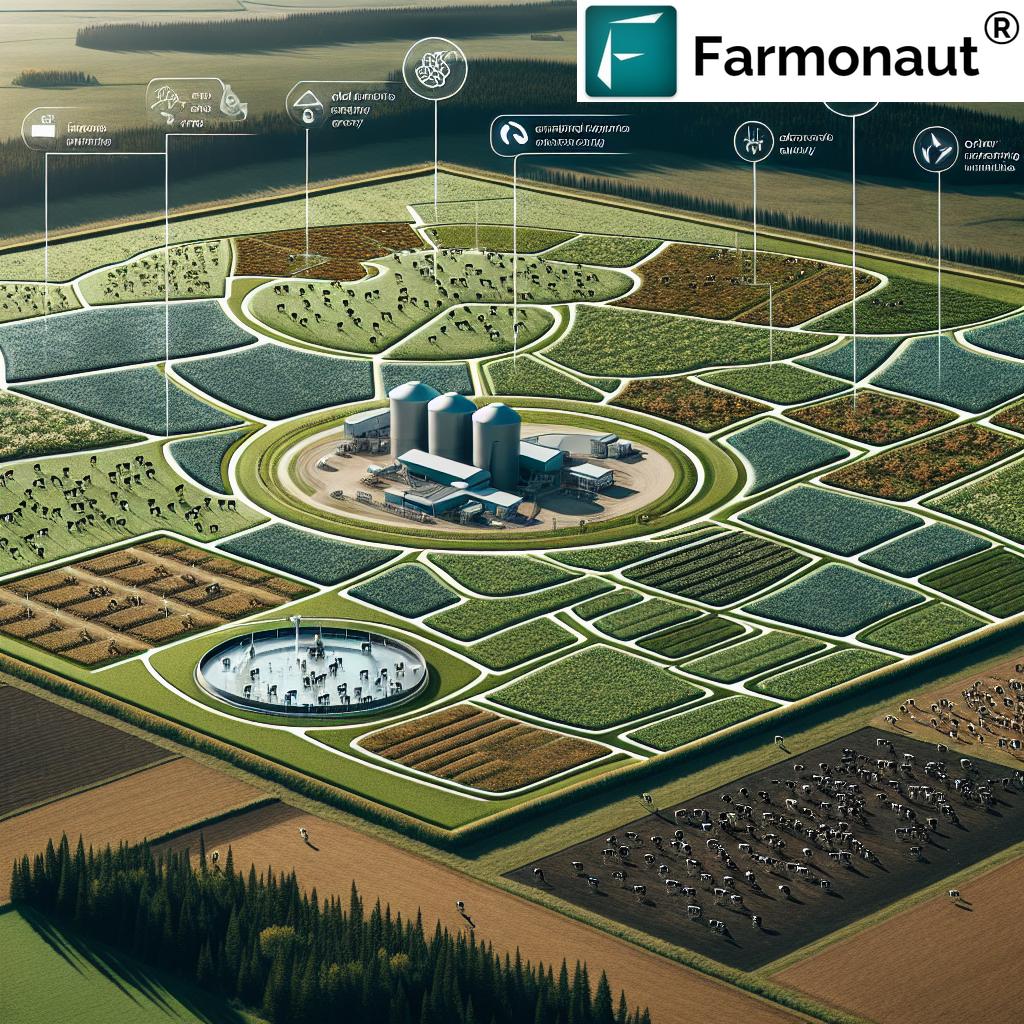
Water Conservation Strategies in Canadian Dairy Farms
Water is a precious resource, and its conservation is crucial for sustainable dairy farming. Canadian dairy farmers are implementing innovative strategies to reduce water usage while maintaining high standards of animal care and milk production.
Effective Water Conservation Techniques:
- Precision Irrigation Systems: Using Farmonaut’s satellite data to optimize irrigation schedules and reduce water waste.
- Water Recycling: Implementing systems to treat and reuse water from milk cooling and cleaning processes.
- Rainwater Harvesting: Collecting and storing rainwater for use in farm operations.
- Drought-Resistant Pastures: Planting grass varieties that require less water while providing nutritious feed for cattle.
These water conservation efforts not only contribute to sustainability goals but also help farms become more resilient to climate change-induced water scarcity.
Soil Protection and Enhancement in Dairy Farming
Healthy soil is the foundation of sustainable dairy farming. Canadian farmers are adopting practices that not only protect but also enhance soil quality, recognizing its crucial role in carbon sequestration and farm productivity.
Soil Protection Techniques:
- Cover Cropping: Planting cover crops to prevent soil erosion and improve soil structure.
- Reduced Tillage: Minimizing soil disturbance to maintain soil integrity and microbial health.
- Rotational Grazing: Implementing grazing systems that allow pastures to recover and prevent overgrazing.
- Soil Testing and Monitoring: Regularly analyzing soil health using Farmonaut’s technology to inform management decisions.
By focusing on soil health, dairy farmers are not only improving their land’s productivity but also contributing significantly to carbon sequestration efforts.
Biodiversity Preservation on Canadian Dairy Farms
“The Canadian dairy industry spans from Quebec to British Columbia, balancing animal welfare, nutrition, and biodiversity preservation across diverse regions.”
Biodiversity is crucial for the long-term health of our ecosystems and agricultural systems. Canadian dairy farmers are taking proactive steps to preserve and enhance biodiversity on their lands.
Biodiversity Initiatives:
- Native Plant Corridors: Creating pathways of native plants to support local wildlife and pollinators.
- Wetland Preservation: Protecting and restoring wetland areas on farmlands to support diverse ecosystems.
- Agroforestry: Integrating trees and shrubs into farming landscapes to create diverse habitats.
- Beneficial Insect Habitats: Establishing areas that attract and support beneficial insects for natural pest control.
These biodiversity efforts not only contribute to environmental health but also enhance the natural beauty of Canadian dairy farms, showcasing the harmony between agriculture and nature.
Innovative Technologies Driving Sustainability
Technology is at the heart of the sustainable transformation in Canadian dairy farming. From advanced monitoring systems to AI-driven decision-making tools, innovative technologies are helping farmers optimize their operations for both productivity and sustainability.
Key Technological Innovations:
- Robotic Milking Systems: Improving animal welfare and reducing labor while optimizing milk production.
- Precision Feeding Technologies: Using data to formulate optimal diets that reduce waste and improve cow health.
- Smart Sensors: Monitoring cow health, milk quality, and environmental conditions in real-time.
- Farmonaut’s Satellite Monitoring: Providing comprehensive farm management insights through advanced satellite imagery and AI analysis.
Access Farmonaut’s API Developer Docs for integration insights
These technologies not only improve efficiency but also contribute significantly to reducing the environmental footprint of dairy farming operations.
The Role of Research in Advancing Sustainable Dairy Farming
Ongoing research plays a crucial role in driving innovation and sustainability in the Canadian dairy industry. Collaboration between farmers, universities, and research institutions is leading to groundbreaking discoveries and practical solutions.
Key Research Areas:
- Methane Reduction: Exploring feed additives and genetic selection to reduce enteric methane emissions.
- Carbon Sequestration: Investigating ways to enhance soil carbon storage in pastures and croplands.
- Renewable Energy Integration: Developing efficient ways to incorporate renewable energy sources into farm operations.
- Climate-Resilient Breeds: Breeding cattle that are more adaptable to changing climate conditions.
This research is not only advancing the science of sustainable dairy farming but also ensuring that Canadian farmers have access to the latest knowledge and tools to achieve their sustainability goals.
Nutrition and Consumer Health: The Sustainable Dairy Advantage
Sustainable dairy farming isn’t just about environmental benefits; it also plays a crucial role in enhancing the nutritional value of dairy products and promoting consumer health. Canadian dairy farmers are increasingly focusing on how sustainable practices can lead to higher quality, more nutritious milk.
Nutritional Benefits of Sustainable Dairy:
- Enhanced Nutrient Density: Cows raised on diverse, nutrient-rich pastures produce milk with higher levels of beneficial nutrients.
- Reduced Chemical Residues: Sustainable practices often involve less reliance on chemical inputs, potentially leading to cleaner milk.
- Improved Omega-3 Content: Grass-fed cows tend to produce milk with higher levels of heart-healthy omega-3 fatty acids.
- Ethical Production: Sustainable practices often align with higher animal welfare standards, which can positively impact milk quality.
By prioritizing sustainable practices, Canadian dairy farmers are not only protecting the environment but also contributing to the health and well-being of consumers across the nation.
Economic Impact of Sustainable Dairy Farming
While the environmental benefits of sustainable dairy farming are clear, it’s equally important to consider the economic implications. Sustainable practices, when implemented effectively, can lead to significant economic benefits for farmers and rural communities.
Economic Advantages:
- Reduced Input Costs: Efficient resource use and regenerative practices can lower expenses for feed, fertilizers, and water.
- Increased Farm Resilience: Diversified, sustainable farms are often better equipped to handle market fluctuations and climate challenges.
- Premium Product Potential: Sustainably produced dairy products may command higher prices in certain markets.
- Long-term Land Value: Improved soil health and biodiversity can enhance the long-term value of farmland.
By embracing sustainable practices and leveraging technologies like Farmonaut, Canadian dairy farmers are positioning themselves for long-term economic success while contributing to environmental conservation.
The Future of Sustainable Dairy Farming in Canada
As we look towards the future, the path to net-zero emissions in Canadian dairy farming is both challenging and exciting. The industry is poised for transformative changes that will reshape how we produce milk and dairy products.
Future Trends and Innovations:
- Carbon Markets: Potential for dairy farms to participate in carbon credit systems for their sequestration efforts.
- Advanced Biotechnology: Development of new feed additives and probiotics to further reduce methane emissions.
- Circular Economy Models: Integrating dairy farms into local food systems and waste management cycles.
- AI and Machine Learning: Further integration of advanced predictive models for farm management, powered by platforms like Farmonaut.
These innovations, coupled with the ongoing commitment of Canadian dairy farmers to sustainability, paint a promising picture for the future of the industry.
Canadian Dairy Farm Sustainability Metrics
| Province | CO2 Emissions Reduction (%) | Water Conservation (liters/cow/day) | Renewable Energy Adoption (% of farms) | Soil Health Improvement (% organic matter increase) | Biodiversity Score (1-10 scale) |
|---|---|---|---|---|---|
| Quebec | 15 | 20 | 30 | 1.5 | 7 |
| Ontario | 12 | 18 | 25 | 1.2 | 6 |
| Alberta | 10 | 22 | 20 | 1.0 | 5 |
| British Columbia | 18 | 25 | 35 | 1.8 | 8 |
This table provides a snapshot of sustainability efforts across major dairy-producing provinces in Canada. It highlights the progress made in key areas such as emissions reduction, water conservation, and renewable energy adoption. While these figures are estimates, they reflect the general trends and variations in sustainability initiatives across different regions of the country.
Conclusion: A Sustainable Future for Canadian Dairy
As we’ve explored throughout this comprehensive overview, the Canadian dairy industry is at the forefront of a sustainability revolution. From innovative farming practices to cutting-edge technologies like those offered by Farmonaut, Canadian dairy farmers are paving the way towards a net-zero future.
The journey to sustainable dairy farming is not just about environmental conservation; it’s about creating a resilient, productive, and ethical industry that can thrive for generations to come. By embracing regenerative agriculture, leveraging advanced technologies, and committing to ongoing research and innovation, Canadian dairy farmers are setting a global standard for sustainable agriculture.
As consumers, we can support this transition by choosing sustainably produced dairy products and appreciating the hard work and dedication of our nation’s farmers. Together, we can ensure that Canadian dairy remains a symbol of quality, sustainability, and innovation on the world stage.
FAQ: Sustainable Dairy Farming in Canada
- Q: What is net-zero emissions in dairy farming?
A: Net-zero emissions mean that the amount of greenhouse gases produced by dairy farming operations is balanced by the amount removed from the atmosphere through various practices and technologies. - Q: How does Farmonaut contribute to sustainable dairy farming?
A: Farmonaut provides satellite-based farm management solutions that help farmers optimize resource use, monitor crop health, and track carbon footprints, all contributing to more sustainable farming practices. - Q: What are some key regenerative agriculture practices in dairy farming?
A: Key practices include rotational grazing, cover cropping, minimal tillage, and integrating diverse plant species in pastures and feed crops. - Q: How does sustainable dairy farming impact milk quality?
A: Sustainable practices often lead to healthier cows and more nutrient-rich feed, which can result in higher quality milk with improved nutritional profiles. - Q: Can small dairy farms implement sustainable practices effectively?
A: Yes, many sustainable practices are scalable and can be implemented by farms of all sizes. Technologies like Farmonaut make precision agriculture accessible to smaller operations.




